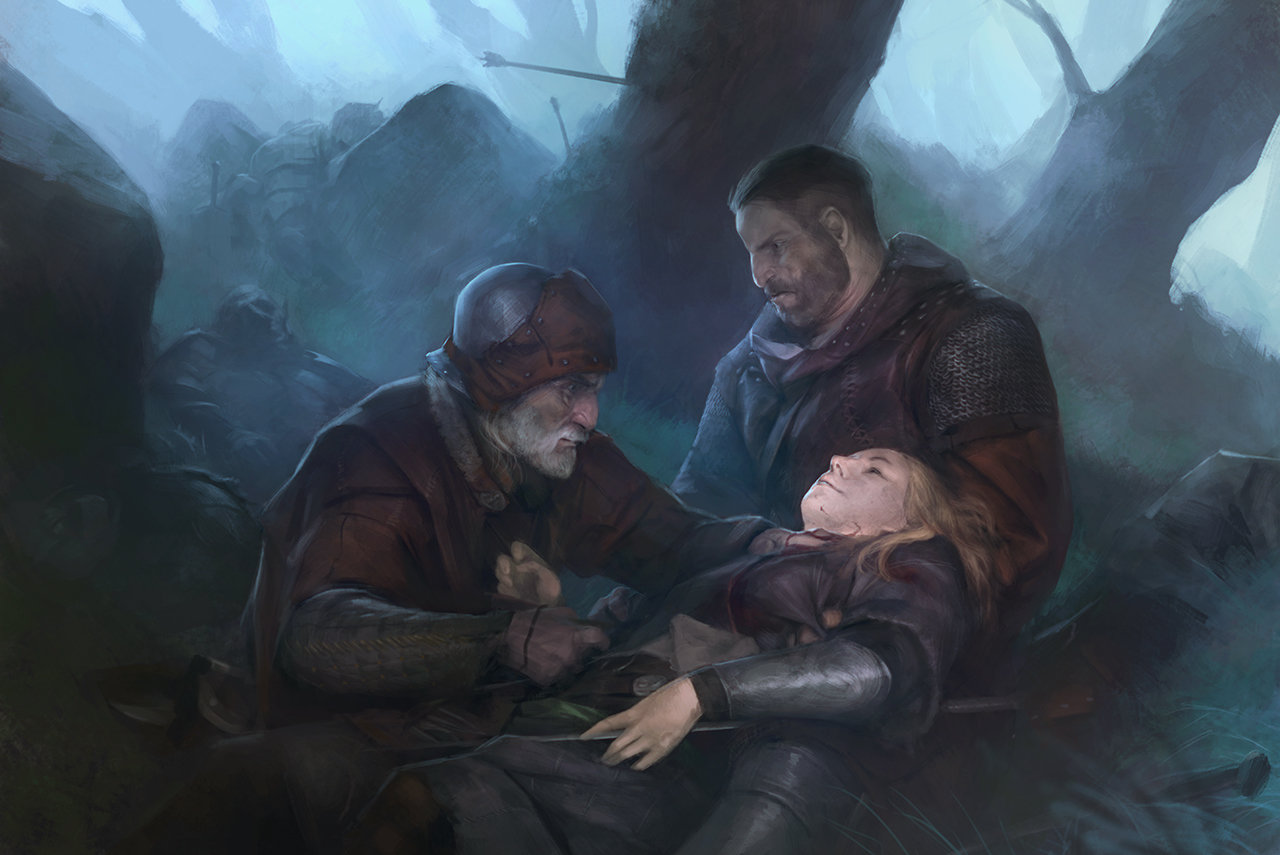I've had a look round and decided to base my Death & Dismemberment system on James Young's So It Looks Like You're Gonna Die pamphlet, which in turn is based on Hack Slash Master's Crit Table (endless iteration!). I've made some changes, which I'll describe below, but some entries are copied wholesale because it's really hard to come up with over 100 distinct injury entries.
The system covers the following:
- Regaining HP
- Ability damage & XP drain
- Wound tables & recovery
- Shock
- Poison
- Disease
 |
| Stepan Alekseev |
Regaining HP
Regaining HP is easy and can be done in one of two ways:- An hour's lunch break with a campfire, food and drink restores 1d8+CON HP.
- A night's rest with a bedroll and a campfire, plus food and drink if you've not rested already, restores all HP. If anything is missing, it instead restores 1d8+CON HP like a lunch break.
Ability damage & XP drain
Some monsters (and other things) can directly damage your stats, you die if any are reduced to 0. Damaged Ability Scores regenerate at a rate of 1 per day if you are active, or 1d6 per day if you rest (no adventuring or strenuous activity).Really dangerous supernatural creatures can drain your XP (they suck the life and vitality right out of you) and cause you to lose levels if enough is drained. If you lose a level due to XP Drain your character immediately ages 2d10 years, and can take penalties due to advanced age. XP Drain cannot be reversed, save by powerful magic or artefacts, but you continue to gain XP as normal from your new total.
Wound tables & recovery
See the basic draft of the wound tables (to be fancied up). If you're taken below 0HP you count the extra damage into the negatives to find where you land on the appropriate table and suffer the effects. If you suffer any further wounds while recovering you progress from where you previously landed. Some entries to be clarified: +Fire, +Acid, +Lightning have specific effects if the wounding attack was based on them; +LMA stands for 'Lightning & Metal Armour', which (at the risk of sounding redundant) can take effect if you're struck by lightning while wearing metal armour.You need bed rest/light duties to recover from wounds. Each wound has a duration that it takes to heal. Once per week, while getting bed rest in comfortable surroundings, you can be treated by another character with the Medicine skill. Success means your recovery is sped up by 1d6 days. Failure means that some element of your Wound becomes permanent due to the physician's incompetence. Alternatively you can pay for a physician to care for you in downtime - each day of medical care paid for counts as double your recovery time.
Both arcane and divine magic can provide healing. HP is restored first, then start knocking off recovery days. Save vs Luck when your wounds are magically healed - if you pass then you can be magically healed again the next day, otherwise you require a week's rest as the magical energies sap your strength. Certain spells can also cure Poison or Disease.
Shock
Shock represents internal and/or ongoing damage from attacks. Unlike wounds, shock stacks each Round with the effects getting progressively worse.There are two important factors here:- A character's Shock Rating - this is the amount that they progress down the shock track each round. When suffering a wound that causes 'Shock X', use this for the initial Shock Rating.
- A character's position on the Shock Level - this determines the ill-effects they suffer on the shock table.
Shock is tracked at the end of each Round, so a character with a Shock Rating of 2 would progress down the track by 2 each Round. Shock can be removed by a successful Medicine skill roll, which reduces a character's Shock Rating and Shock Level by the margin of success on the roll (minimum 1). Bandages boost a Medicine skill roll to remove shock by +1 and are used up whether or not the roll is successful. The ill effects of shock are incremental - each level represents the total penalty. Shock is treated as ability damage - a character will recover from the ill effects of shock once their stats have recovered to their normal levels.
Poison
Like Shock this builds up over time and has a Poison Rating and Poison Level, but is tracked every Turn instead of every Round.The Medicine skill can't help you here, but save vs Doom each Turn - on a success you lose a point of Poison Rating and decrease 1d6+CON spaces on the Poison Level track. Like shock, the poison track is not cumulative.

No comments:
Post a Comment